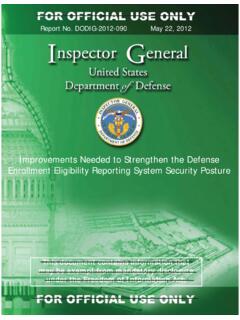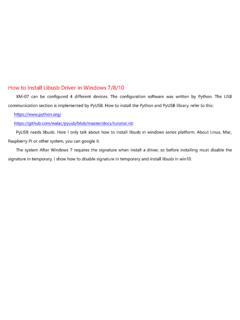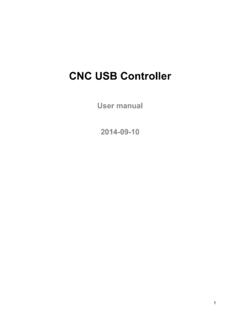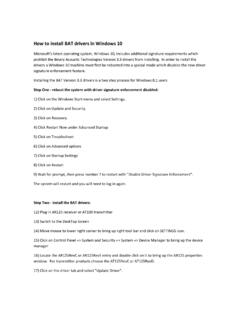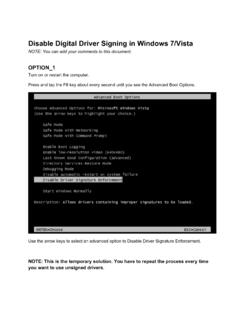Transcription of UEFI Secure Boot Customization - U.S. Department of Defense
1 UNCLASSIFIED UNCLASSIFIED National Security Agency Cybersecurity Technical Report UEFI Secure Boot Customization September 2020 ver. S/N: U/OO/168873-20 PP-20-0652 UNCLASSIFIED National Security Agency | Cybersecurity Technical Report UEFI Secure Boot Customization U/OO/168873-20 | PP-20-0652 | Sep 2020 Ver. ii UNCLASSIFIED Notices and history Document change history Date Version Description 15 September Publication release. 16 September Updated server UEFI hash interface image and text. Disclaimer of warranties and endorsement The information and opinions contained in this document are provided "as is" and without any warranties or guarantees. Reference herein to any specific commercial products, process, or service by trade name, trademark, manufacturer, or otherwise, does not necessarily constitute or imply its endorsement, recommendation, or favoring by the United States Government.
2 The views and opinions of authors expressed herein do not necessarily state or reflect those of the United States Government, and shall not be used for advertising or product endorsement purposes. Trademark recognition Dell, EMC, Dell EMC, iDRAC, Optiplex, and PowerEdge are registered trademarks of Dell, Inc. HP, HPE, HP Enterprise, iLO, and ProLiant are registered trademarks of Hewlett-Packard Company. Linux is a registered trademark of Linus Torvalds. Microsoft, Hyper-V, Surface, and Windows are registered trademarks of Microsoft Corporation. Red Hat, Red Hat Enterprise Linux (RHEL), CentOS, and Fedora are registered trademarks of Red Hat, Inc. VMware and ESXI are registered trademarks of VMware, Inc. Trusted Computing Group, TCG, Trusted Platform Module, TPM, and related specifications are property of the Trusted Computing Group. Unified Extensible Firmware Interface, UEFI, UEFI Forum, and related specifications are property of the UEFI Forum.
3 UNCLASSIFIED National Security Agency | Cybersecurity Technical Report UEFI Secure Boot Customization U/OO/168873-20 | PP-20-0652 | Sep 2020 Ver. iii UNCLASSIFIED Publication information Author(s) National Security Agency Cybersecurity Directorate Endpoint Security Division Platform Security Section Contact information Client Requirements / General Cybersecurity Inquiries: Cybersecurity Requirements Center, 410-854-4200, Media inquiries / Press Desk: Media Relations, 443-634-0721, Purpose This document was developed in furtherance of NSA's cybersecurity missions. This includes its responsibilities to identify and disseminate threats to National Security Systems, Department of Defense information systems, and the Defense Industrial Base, and to develop and issue cybersecurity specifications and mitigations. This information may be shared broadly to reach all appropriate stakeholders.
4 Additional resources Please visit the NSA Cybersecurity GitHub at for additional resources relating to UEFI Secure Boot and the Customization process. UNCLASSIFIED National Security Agency | Cybersecurity Technical Report UEFI Secure Boot Customization U/OO/168873-20 | PP-20-0652 | Sep 2020 Ver. iv UNCLASSIFIED Executive summary Secure Boot is a boot integrity feature that is part of the Unified Extensible Firmware Interface (UEFI) industry standard. Most modern computer systems are delivered to customers with a standard Secure Boot policy installed. This document provides a comprehensive guide for customizing a Secure Boot policy to meet several use cases. UEFI is a replacement for the legacy Basic Input Output System (BIOS) boot mechanism. UEFI provides an environment common to different computing architectures and platforms. UEFI also provides more configuration options, improved performance, enhanced interfaces, security measures to combat persistent firmware threats, and support for a wider variety of devices and form factors.
5 Malicious actors target firmware to persist on an endpoint. Firmware is stored and executes from memory that is separate from the operating system and storage media. Antivirus software, which runs after the operating system has loaded, is ineffective at detecting and remediating malware in the early-boot firmware environment that executes before the operating system. Secure Boot provides a validation mechanism that reduces the risk of successful firmware exploitation and mitigates many published early-boot vulnerabilities. Secure Boot is frequently not enabled due to issues with incompatible hardware and software. Custom certificates, signatures, and hashes should be utilized for incompatible software and hardware. Secure Boot can be customized to meet the needs of different environments. Customization enables administrators to realize the benefits of boot malware defenses, insider threat mitigations, and data-at-rest protections.
6 Administrators should opt to customize Secure Boot rather than disable it for compatibility reasons. Customization may depending on implementation require infrastructures to sign their own boot binaries and drivers . Recommendations for system administrators and infrastructure owners: Machines running legacy BIOS or Compatibility Support Module (CSM) should be migrated to UEFI native mode. Secure Boot should be enabled on all endpoints and configured to audit firmware modules, expansion devices, and bootable OS images (sometimes referred to as Thorough Mode). Secure Boot should be customized, if necessary, to meet the needs of organizations and their supporting hardware and software. Firmware should be secured using a set of administrator passwords appropriate for a device's capabilities and use case. Firmware should be updated regularly and treated as importantly as operating system and application updates.
7 A Trusted Platform Module (TPM) should be leveraged to check the integrity of firmware and the Secure Boot configuration. UNCLASSIFIED National Security Agency | Cybersecurity Technical Report UEFI Secure Boot Customization U/OO/168873-20 | PP-20-0652 | Sep 2020 Ver. v UNCLASSIFIED Contents Notices and history ..ii Document change history ..ii Disclaimer of warranties and endorsement ..ii Trademark recognition ..ii Publication information ..iii Author(s) ..iii Contact information ..iii Additional resources ..iii Executive summary .. iv Contents .. v 1 Unified Extensible Firmware Interface (UEFI).. 1 2 UEFI Secure Boot .. 2 Platform-Specific Caveats .. 4 3 Use Cases For Secure Boot .. 5 Anti-Malware .. 5 Insider Threat Mitigation .. 6 Data-at-Rest .. 7 4 Customization .. 7 Dependencies .. 7 Backup Factory Values .. 8 Backup Secure Boot Values .. 9 EFI signature List (ESL) 11 Initial Provisioning of Certificates and Hashes.
8 12 Create Keys and Certificates .. 13 Sign Binaries .. 14 Calculate and Capture Hashes .. 15 Load Keys and Hashes .. 17 Updates and Changes .. 22 Update the PK .. 22 Update a KEK .. 22 Update the DB or DBX .. 23 Update MOK or MOKX .. 23 Validation .. 23 5. Advanced Customizations .. 24 Trusted Platform Module (TPM) .. 24 Trusted Bootloader .. 26 6 References .. 27 Cited Resources .. 27 Command References .. 27 Uncited Related Resources .. 27 UNCLASSIFIED National Security Agency | Cybersecurity Technical Report UEFI Secure Boot Customization U/OO/168873-20 | PP-20-0652 | Sep 2020 Ver. vi UNCLASSIFIED 7 Appendix .. 28 UEFI Lockdown Configuration .. 28 Acronyms .. 30 Frequently Asked Questions (FAQ) .. 32 UNCLASSIFIED National Security Agency | Cybersecurity Technical Report UEFI Secure Boot Customization U/OO/168873-20 | PP-20-0652 | Sep 2020 Ver. 1 UNCLASSIFIED 1 Unified Extensible Firmware Interface (UEFI) Unified Extensible Firmware Interface (UEFI) is an interface that exists between platform hardware and software.
9 UEFI is defined and updated via specifications maintained by the UEFI Forum industry body. Support for UEFI is a requirement for some newer software and hardware. Legacy boot solutions, such as Basic Input/Output System (BIOS), are being phased out in 2020 (Shilov 2017). UEFI defines a consistent Application Programming Interface (API) and a set of environment variables common to all UEFI platforms. Uniformity enables OS, driver, and application developers to build for UEFI regardless of platform, architecture, vendor, or assortment of system components. Manufacturers and developers can take advantage of UEFI s extensibility to create additional features, add new product support, and create protocols to support emerging solutions. Legacy BIOS involves a wide variety of unique implementations, update solutions, and interpretations of platform services ( Advanced Configuration and Power Interface (ACPI)).
10 UEFI establishes a standard that separates portions of code into modules, defines mechanisms for module interaction, and empowers component vendors to reuse modules across product lines. Modules also enable vendors to swap out content via updates that can be delivered remotely over commercial infrastructure management and update solutions (Golden 2017). UEFI boot occurs in standards-defined phases (UEFI Forum 2017). Figure 1 shows an overview of the phases. The SEC, PEI, DXE, and BDS phases are handled by platform firmware. The Bootloader and OS Kernel phases are handled by software. UEFI Boot Phases Legacy BIOS has been part of the computing ecosystem since 1975. UEFI entered the standards and commercial world in 2005 after having existed as an internal Intel Corporation project for many years prior (referred to as Extensible Firmware Interface EFI). The UEFI Forum and vendor partners recognized the potential for disruption migrating from BIOS to UEFI would cause on the computing industry and established products.




